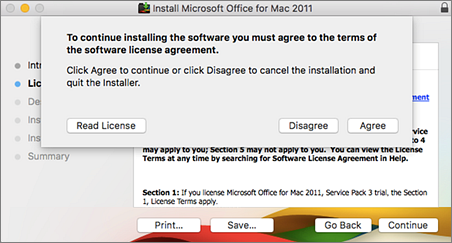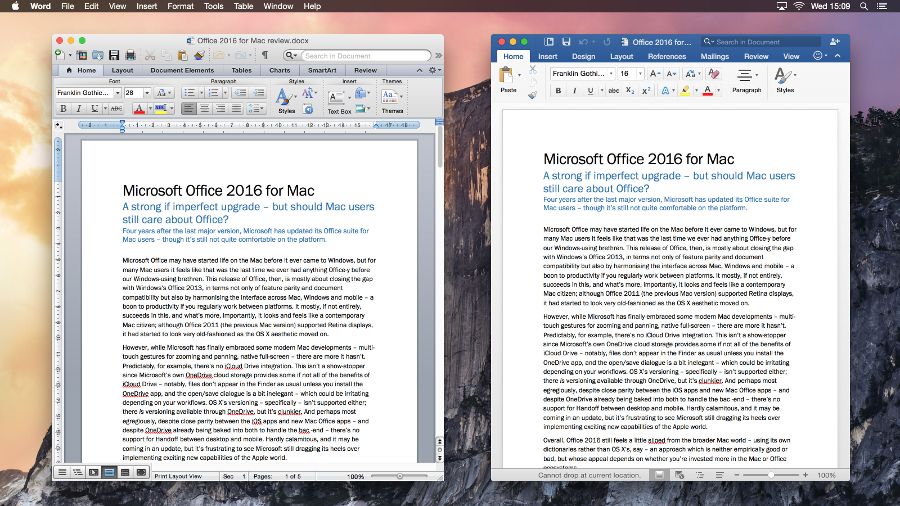- Mar 12, 2020 Microsoft Office 2016 - Unmistakably Office, designed for Mac. The new versions of Word, Excel, PowerPoint, Outlook, and OneNote provide the best of both worlds for Mac users - the familiar Office experience paired with the best of Mac. If you already use Office on a PC or iPad, you will find yourself right at home in Office 2016 for Mac.
- Sep 24, 2018 Commercial volume-licensed (trusted) customers can access Office 2019 starting today. Office 2019 is now available for consumer and commercial customers. For consumer customers in China, India, and Japan, Office 2019 suites will be available in the next few months. Certain features are only available in the Mac or Windows versions of Office 2019.
- Dec 02, 2019 Here's what you can do if you upgraded to Catalina on your Mac and Microsoft Office won't work anymore. Of Microsoft Office is older than Office 2016 v15.35, you’ll have to choose from a.
- Mar 13, 2020 Update Mac OS X. Open the App store and click on the Updates button. Install the updates. After, in any Office application go to the Help menu and choose Check for Updates to launch the AutoUpdate app. Let AutoUpdate install updates and then restart your Mac. I am an unpaid volunteer and do not work for Microsoft.
- Microsoft Office 2016 Won't Open On Mac March 2019 Calendar
- Microsoft Office 2016 Won't Open On Mac March 2019 Calendar
- Microsoft Office 2016 Won't Open On Mac March 2019 Release
Office 2019 perpetual — Office 2019 purchases currently unlock local notebook support for OneNote 2016. Starting in March 2020, when you install Office 2019, the OneNote desktop app will be installed alongside the Word, PowerPoint, and Excel desktop apps. Can I continue using OneNote 2016? Select the Microsoft Office product that is right for your home or business. One-time purchase for 1 PC or Mac; Classic 2019 versions of Word, Excel, PowerPoint and Outlook. This plan works with Office 2019, Office 2016, and Office 2013. Previous versions of Office, such as Office 2010, may work with Office 365 with reduced functionality.
As of September 25, 2017, macOS 10.13 High Sierra is publicly available for all Mac users to install. Office 2016 for Mac is fully supported on High Sierra. For the best experience, we recommend you update Office to version 15.38 or later.
For updates regarding macOS 10.14 Mojave, see Microsoft Office support for macOS 10.14 Mojave.
Office 2016 for Mac
See 'What version of Office am I using?' if you don't know what version you're on.
Note: This article applies only to Office 365 operated by 21Vianet in China.Ready to install Office 2016 for Mac for Office 365? RequirementsTo use Office for Mac 2016, you must have:.Mac OS X 10.10 or later.One of the following subscriptions:.Office 365 Enterprise E3.Office 365 Business.Office 365 Business Premium.Office 365 ProPlus.Office 365 ProPlus for Students.Office 365 ProPlus for Faculty.Office 365 Midsize Business.Office 365 Small Business Premium. Apple install of microsoft office 365 on mac. This article tells you how. Note: Office 2016 for Mac for Office 365 operated by 21Vianet is not offered through the Apple store.
Version of Office | Supportability |
|---|---|
15.35 and later | Office 2016 for Mac is fully supported on macOS 10.13 High Sierra. If you encounter issues using Office 2016 for Mac, please send us feedback so we can address them. In Word, Excel, PowerPoint and OneNote, you can click on the Send a Smile icon in the top-right of the app. For Outlook, choose Contact Support from the Help menu. |
15.34 and earlier | These versions are not supported on 10.13. In some cases, you may not be able to launch the Office apps. For example, users will see the following error message when attempting to launch Outlook 2016 ver. 15.34: If you installed Outlook 2016 ver. 15.34 or earlier, and are not being offered an update to 15.35 or later, download the latest Office 2016 for Mac Suite Installer here. |
Office for Mac 2011
Word, Excel, PowerPoint, Outlook and Lync have not been tested on macOS 10.13 High Sierra, and no formal support for this configuration will be provided.
Since October 10, 2017, Office for Mac 2011* is no longer supported. This means there will be no new security updates, non-security updates, free or paid assisted support options, or technical content updates. Refer to the Microsoft Support Lifecycle for more information.
* Lync for Mac 2011 has a limited time of Extended Support for security fixes.
Question: I upgraded to Catalina on my Mac and now Microsoft Office won’t work; what can I do?
Answer: One of the side effects of tech companies taking their platforms to new levels is that, often times, older software programs will no longer work.
The most recent version of Apple’s MacOS — known as Catalina — is having a major impact on those who upgraded without understanding that their older 32-bit programs would no longer run.
 Once you have your product key, see Activate Office for Mac 2011. When you install or reinstall Microsoft Office, you are prompted to enter the product key. The product key is used during installation to 'unlock' the software. Mar 19, 2020 If you can't use Migration Assistant, then just buy a new product key. 2011 is discontinued and is selling very cheap on eBay (about $20) US. I am an unpaid volunteer and do not work for Microsoft. 'Independent Advisors' work for contractors hired by Microsoft.
Once you have your product key, see Activate Office for Mac 2011. When you install or reinstall Microsoft Office, you are prompted to enter the product key. The product key is used during installation to 'unlock' the software. Mar 19, 2020 If you can't use Migration Assistant, then just buy a new product key. 2011 is discontinued and is selling very cheap on eBay (about $20) US. I am an unpaid volunteer and do not work for Microsoft. 'Independent Advisors' work for contractors hired by Microsoft.
If your version of Microsoft Office is older than Office 2016 v15.35, you’ll have to choose from a variety of costly or time consuming and complicated options.
If you have Office 2016, you should be able to upgrade to the 64-bit version through Microsoft’s standard upgrade process if for some reason it hasn’t already been updated.
Microsoft Office 2016 Won't Open On Mac March 2019 Calendar
Option 1: Purchase new software
You can purchase the Office Home & Student 2019 bundle from Microsoft for $149.99 or the Office Home & Business bundle for $249.99. The primary difference in the two packages is the business version includes Outlook.
Option 2: Start renting Microsoft Office
Microsoft is trying to get users to convert from a single purchase package that will eventually expire to their subscription 'SaaS' (Software as a Service) platform known as Office 365.
This means you either pay monthly ($6.99 for Home & Student) or annually ($69.99 for Home & Student or $99 for Business) from now on.
Option 3: Switch to Google’s offerings

If your needs for productivity software are very basic, you may find the free options available from Google through a Google Drive account to be acceptable.

It includes Docs, Sheets and Slides which are Google’s version of Word, Excel and PowerPoint, although nowhere near as powerful. Though it’s a web-based tool, there are options for editing your documents when you are offline.
Option 4: Revert back to Mojave
Microsoft Office 2016 Won't Open On Mac March 2019 Calendar
There is no simple way to go back to the previous version (Mojave), so this option is very time consuming and complicated, as you’ll have to wipe your hard drive and reinstall everything. Depending upon which version of the MacOS your computer shipped with, you may have to use an external hard drive to complete the reversion.
How to check for 32-bit programs
For those who are considering an upgrade to Catalina, a good first step is to see what 32-bit programs you are currently running to determine if they are important to you or not.
To do this, click on the Apple icon in the upper left corner, then on 'About This Mac' and then on 'System Report.' When the report opens up, scroll down to the 'Software' section and click on 'Applications.'
An alphabetical list of applications will appear with various details about each one. If you scroll to the far right, you should see a column that says '64-Bit' and the words 'Yes' or 'No' for each application. To make it easier to see the Application Name and whether it’s 64-bit or not, drag the 64-bit header from the far right to the far left so it’s right next to the 'Application Name' column.
Go through the list looking for your critical programs to make sure they are 64-bit or to see if a 64-bit version is available from the creator of the program before upgrading to Catalina.
Ken Colburn is the founder and CEO of Data Doctors Computer Services. Ask any tech question at: facebook.com/DataDoctors.